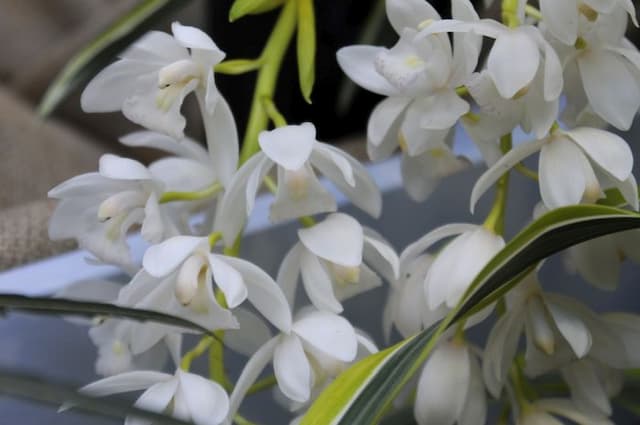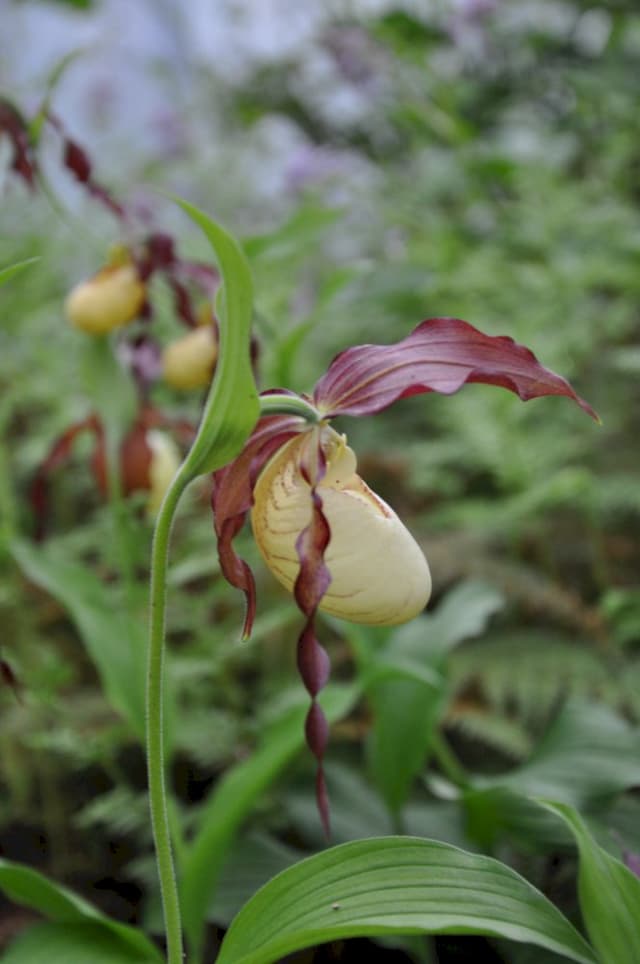Broad-Leaved Marsh Orchid Dactylorhiza elata

ABOUT
The plant in question, commonly known as the Broad-Leaved Marsh Orchid, is a striking and elegant perennial. Characterized by its lush, lance-shaped leaves, the appearance of the foliage is green, sometimes marked with darker spots or streaks that add contrast and visual interest. These leaves emerge from the base, forming a rosette that provides a lush backdrop for the flowers. The flower spike of the Broad-Leaved Marsh Orchid is particularly impressive, with a dense arrangement of blooms that can vary in color, often showcasing shades of purple, pink, or sometimes white. Each individual flower is intricately patterned, with a three-lobed lip prominently displaying various spots, lines, or loops that help attract pollinators. The petals are gracefully curved, contributing to the alluring silhouette of the flower spike. Sitting atop a sturdy stem, the flower spike commands attention with its vertical arrangement, inviting onlookers to admire the detailed arrangement of the blossoms. The blooms themselves are known for their symmetrical appearance, with a structure that's both delicate and complex. The harmonious arrangement of sepals and petals framing the central lip adds to the overall aesthetic of the flower spike. While the Broad-Leaved Marsh Orchid is a plant that enjoys moist soil conditions, its overall appearance is one of resilience and vitality, a testament to nature's ability to create beauty in varied environments. With the seasonal cycle, this orchid re-emerges, bringing with it the lush greenery and resplendent blooms that make it such a beloved addition to its native habitats.
About this plant
 Names
NamesSynonyms
Robust Marsh Orchid, Broad-Leaved Marsh Orchid, Elata Marsh Orchid.
Common names
Orchis elata
 Toxicity
ToxicityTo humans
Dactylorhiza elata, commonly known as the robust marsh orchid, does not have a widespread reputation for being toxic to humans. There is limited information available on its toxicity, which suggests that it is generally considered safe around humans, and accidental ingestion does not typically lead to serious poisoning. However, as with many plants, it is always possible for individuals to have allergic reactions or stomach upset after consuming plant material they are not accustomed to. Therefore, it is prudent to avoid ingesting parts of this or any wild plant without proper knowledge of its edibility and potential effects.
To pets
The robust marsh orchid is also not widely recognized as being toxic to pets. Similar to the information available on its effects on humans, there are no well-documented cases of toxicity in pets from consuming this plant. Nevertheless, it’s essential to prevent pets from eating ornamental plants as a general precaution, since individual animals might have sensitivities or allergic reactions. If your pet ingests a part of this plant and you observe any unusual symptoms, it’s always best to consult with a veterinarian.
 Characteristics
CharacteristicsLife cycle
Perennials
Foliage type
Deciduous
Color of leaves
Green
Flower color
Pink
Height
1-2 feet (30-60 cm)
Spread
0-1 feet (0-30 cm)
Plant type
Herb
Hardiness zones
5
Native area
Europe
Benefits
 General Benefits
General Benefits- Ornamental Value: Dactylorhiza elata, also known as the robust marsh orchid, is prized for its aesthetically pleasing flowers, making it a popular choice for gardens and decorative displays.
- Biodiversity Support: The robust marsh orchid provides habitat and food resources for a variety of pollinators, including bees, butterflies, and other insects, thereby supporting local ecosystems.
- Educational Importance: As a species with specific habitat requirements, Dactylorhiza elata serves as an educational specimen for botany and ecology studies, highlighting the significance of wetland conservation.
- Ecological Indicator: This plant can be an indicator species for the health of wetland ecosystems, signaling good water quality and the presence of other important plant and animal species.
- Cultural Significance: In some regions, the robust marsh orchid holds cultural value, being part of local traditions, conservation efforts, and nature-inspired art and folklore.
- Genetic Diversity: The plant contributes to the genetic diversity of the orchid family and can be important for research and conservation of rare or threatened orchid species.
- Nature Photography: Its striking appearance makes Dactylorhiza elata a sought-after subject for nature photographers and plant enthusiasts who wish to document the beauty of wild orchids.
 Medical Properties
Medical PropertiesThis plant is not used for medical purposes.
 Air-purifying Qualities
Air-purifying QualitiesThis plant is not specifically known for air purifying qualities.
 Other Uses
Other Uses- Dactylorhiza elata, commonly known as the Broad-Leaved Marsh Orchid, has been used in traditional jewelry making, where its dried flowers are encased in transparent materials to create unique pendants and earrings.
- The plant is sometimes used in educational settings to teach students about boggy meadow ecosystems and the specific conditions required by various orchid species.
- Broad-Leaved Marsh Orchid can serve as a natural dye source, providing hues for textiles and art, though this is not widely practiced.
- Its distinct flower structure has been an inspiration for artists and designers, influencing patterns in textiles, wallpapers, and other decorative arts.
- In some regions, the Broad-Leaved Marsh Orchid is a symbol of wetland conservation efforts and is used in promotional materials and campaigns.
- The plant is occasionally used in the floristry industry, especially for creating specialty wedding boutonnieres and corsages due to its unique appearance.
- Enthusiasts of miniature garden landscapes sometimes use the Broad-Leaved Marsh Orchid to add color and diversity to their creations.
- This orchid has been referenced in poetry and literature, symbolizing the transient beauty of nature and often representing themes of fragility and rarity.
- In some countries, the Broad-Leaved Marsh Orchid is cultivated for ornamental purposes, appreciated for its striking flowers and as a specimen in wildflower gardens.
- It has also been used in biodegradation studies to assess the impact of environmental pollution on sensitive plant species in wetland areas.
Interesting Facts
 Feng Shui
Feng ShuiThe plant Dactylorhiza elata is not used in Feng Shui practice.
 Zodiac Sign Compitability
Zodiac Sign CompitabilityThe plant Dactylorhiza elata is not used in astrology practice.
 Plant Symbolism
Plant Symbolism- Beauty and Grace: Dactylorhiza elata, commonly known as the Robust Marsh Orchid, often embodies beauty and gracefulness due to its striking and delicate features.
- Rarity and Preciousness: As orchids are sometimes rare and prized, the Robust Marsh Orchid is also considered to symbolize something precious and of great value.
- Spiritual Enlightenment: Orchids are sometimes associated with spiritual growth and enlightenment, and this could extend to the Robust Marsh Orchid, suggesting a connection to higher levels of consciousness.
- Fertility and virility: The orchid genus as a whole has been linked to fertility and virility, which could imply that the Robust Marsh Orchid shares this symbolism.
- Complexity and Variety: Given the vast variety within the orchid family and the complex design of many orchids, the Robust Marsh Orchid may represent the intricate diversity of life.
 Water
WaterThe Tall Marsh Orchid requires moist conditions but should not be waterlogged. It's best to water this plant once a week, providing enough water to keep the soil consistently damp. Depending on the size of the pot, this typically means using about 16 to 24 ounces of water. Ensure good drainage to avoid root rot. During the active growing season, from spring to early fall, the watering frequency should be maintained; reduce watering during the dormant winter period but do not allow the soil to completely dry out.
 Light
LightThe Tall Marsh Orchid thrives in partial shade to bright, indirect sunlight. It should be placed in a spot where it receives dappled sunlight or a few hours of morning sun followed by shade in the afternoon. Avoid exposing the plant to direct midday sunlight, as this can scorch the leaves.
 Temperature
TemperatureThe Tall Marsh Orchid prefers cool to moderate temperature conditions, typically between 50°F and 70°F. It can endure minimum temperatures down to about 40°F but should be protected from frost. The plant should not be exposed to temperatures above 80°F for extended periods. Maintain a steady temperature range to ensure the plant's health.
 Pruning
PruningPruning is not typically necessary for the Tall Marsh Orchid except for the removal of dead or yellowing leaves. Any pruning should be done after the flowering period to avoid disrupting blooming. Cut back any spent flower stems to the base to encourage future growth.
 Cleaning
CleaningAs needed
 Soil
SoilThe Tall Marsh Orchid thrives in a well-draining soil mix with a pH of 5.5 to 6.5. An ideal mixture for this orchid could be composed of sphagnum peat, perlite, and loam in equal parts to ensure proper moisture retention and aeration. Regularly check the soil pH to maintain the slightly acidic conditions preferred by the Tall Marsh Orchid.
 Repotting
RepottingThe Tall Marsh Orchid, often repotted every two to three years, requires fresh medium to prevent compaction and maintain nutrient availability. It's best to repot when new growth begins, typically in the spring, to minimize stress on the plant.
 Humidity & Misting
Humidity & MistingThe Tall Marsh Orchid prefers a high humidity level, around 70-80%, to mimic its natural, damp habitat conditions. Consistent humidity within this range supports healthy growth and bloom production.
 Suitable locations
Suitable locationsIndoor
Place Tall Marsh Orchid in bright, indirect light with high humidity.
Outdoor
Plant in dappled light, moist soil, shelter from strong winds.
Hardiness zone
5-9 USDA
 Life cycle
Life cycleDactylorhiza elata, commonly known as the Robust Marsh Orchid, begins its life cycle as a seed, which, upon finding suitable mycorrhizal fungi in wet, calcareous environments, undergoes germination. The seed develops into a protocorm, an organ that allows the seedling to absorb nutrients from its fungal symbiont. After this initial stage, the plant grows leaves and a tuberous root system, entering a vegetative state where it carries out photosynthesis to mature. In this phase, the plant may form a rosette of leaves at ground level. Following vegetative growth, the Robust Marsh Orchid enters its reproductive phase, characterized by the development of a flower spike bearing numerous purple-pink flowers that engage in cross-pollination, predominantly via insects. After pollination and fertilization, the plant forms fruit capsules containing numerous dust-like seeds, which are dispersed by the wind, completing the life cycle and potentially colonizing new areas.
 Propogation
PropogationPropogation time
Spring to Summer
The most popular method of propagation for Dactylorhiza elata, commonly known as the Robust Marsh Orchid, is through division. This process is ideally done when the plant is not in active growth, often in late summer or early fall after the plant has finished blooming. To propagate by division, carefully lift the orchid from the ground, ensuring that the tubers and root system are intact. Clean any dead material off the tubers and gently pull apart or cut through the fleshy roots to separate the plant into smaller sections, each with at least one growth shoot. Replant these divisions immediately, placing them at the same depth they were growing at before, and water them thoroughly. It's crucial to maintain high humidity around the plant during the initial stages of regrowth to help the divisions establish.









